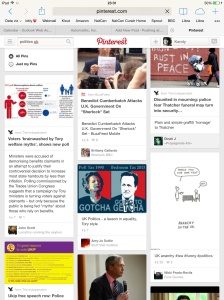By
Tianzhang Zhao, student in the MA
in Social Media at the University
of Westminster
Watch the video here! https://www.youtube.com/watch?v=9f-tJ3G5uRg
The video is about 30 minutes long and is divided into 9 parts:
The first part is about the relationship between making things, individuals’ happiness, and society. In this book, David Gauntlett promotes that making things would reflect and realize individuals’ values, which would bring people happiness and would further influence society as a whole in a positive way. Therefore, this section is focused on the question if ‘making things’ can raise individuals’ happiness and advance a good society.
The second part is about creativity. As David Gauntlett says in his book, creativity is “a process which brings together at least one active human mind, and the material or digital world, in the activity of making something which is novel in that context, and is a process which evokes a feeling of joy”. In this section, David Gauntlett illustrates the idea of creativity in detail and where his idea about creativity comes from. Simon Lindgren discusses David Gauntlett’s definition of creativity and explains what creativity is to him.
The third part is about the transition from a ‘sit back and be told’ culture to a ‘making and doing’ culture. This section focuses on how this transition happens and the future of the Internet.
The fourth part is about the relationship between the ‘making and doing’ culture and social media. In this section, David Gauntlett and Simon Lindgren discuss if social media be considered as a ‘product’ emerging from the ‘making and doing’ culture.
The fifth part is about how to motivate people to embrace the ‘making and doing’ culture. In the book, David Gauntlett points out that people today are still used to only ‘watch’, ‘listen’ and ‘share’, but do so much participate in making and doing things. Iin this section of the video, David Gauntlett and Simon Lindgren talk about how one can best motivate people to go from the broadcast mode of media use towards real participation.
The sixth part is about how to describe people who use the Internet and social media. Both David Gauntlett and Simon Lindgren do not want use the word ‘audience’ to describe people who use the Internet and social media. So, what term do two scholars employ? You can find out in the video.
The seventh part is about the ‘creative X’. ‘X’ represents the term that can best be used to describe people who use the Internet and social media. In this section, David Gauntlett and Simon Lindgren talk about what is a ‘creative X’ to them and what kind of behavior could be called ‘creative’.
The eighth part is about free digital labour. In the book, David Gauntlett points out that the social media owners are making money from the ‘creative X’ and squeeze their labour. In this section, David Gauntlett and Simon Lindgren talk about their ideas towards this issue.
The final part is about the users’ awareness of free labour. David Gauntlett and Simon Lindgren talk about whether people online have awareness of the free labour issue or not.

